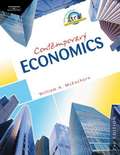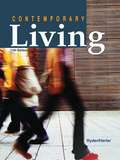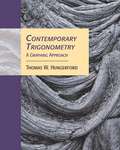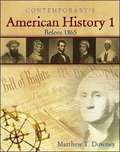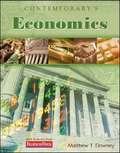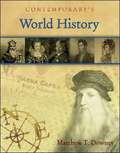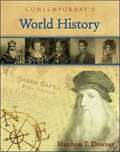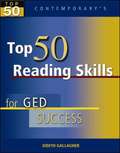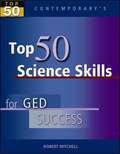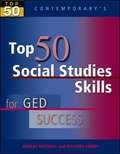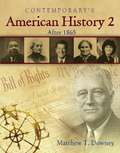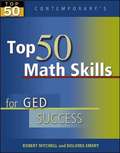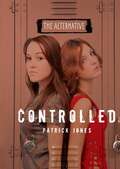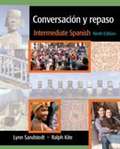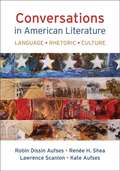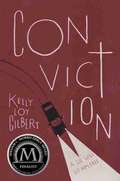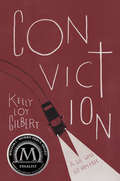- Table View
- List View
Contemporary Chemistry: The Physical Setting
by Paul S. Cohen Saul L. GeffnerContemporary Chemistry: The Physical Setting is an introduction to the study of chemistry, which follows the New York State Core Curriculum. With this book, you can gain a firm understanding of the fundamental concepts of chemistry--a base from which you may confidently proceed to further studies in chemistry, or simply to a deeper appreciation of the world of science in which you live.
Contemporary Economics
by William A. MceachernMcEachern, an economist and teacher, provides an introductory textbook on economics that explains related theory, events, and institutions by using timely real-world examples. Each of the National Content Standards of the National Council on Economic Education is covered. Two new chapters in this edition discuss personal finance, specifically consumer responsibilities and protections and managing money. Annotation ©2007 Book News, Inc., Portland, OR (booknews.com)
Contemporary Living
by Marjorie B. Harter Verdene RyderWith this new edition, Contemporary Living will continue to be a leading text and popular choice by teachers. This text provides an objective, sensitive presentation of contemporary issues facing today's students. Students will study their development as individuals and family members and learn to identify the attitudes, values, standards, and goals that will influence their decision making. Many new topics have been added to update text content, along with 125 new illustrations.<BR>-- New topics include using the management process; making a career plan; teamwork skills; and strategies for job success.<BR>-- More information is provided on lifespan development, including young adulthood, as well as child guidance techniques.<BR>-- Technology applications have been added throughout, such as using the Internet to find jobs and shopping online.<BR>-- A new end-of-chapter feature called "To Think About" involves topics, questions, and activities requiring critical thinking.
Contemporary Living
by Marjorie B. Harter Verdene Ryder- Added content on early brain development, SIDS, and child guidance techniques. - New topics include using the management process; making a career plan; teamwork skills; strategies for job success; and life span development.
Contemporary Living
by Marjorie B. Harter Verdene Ryder- Added content on early brain development, SIDS, and child guidance techniques. - New topics include using the management process; making a career plan; teamwork skills; strategies for job success; and life span development.
Contemporary Living
by Verdene RyderContemporary Living explores the issues facing students and provides the information needed to make wise decisions. The text addresses topics such as personal development, relationships with family and friends, career options, healthful living, relating to peers, dealing with family crises,and managing family living. Students gain critical-thinking skills while they learn about alternatives to different situations so they can make the best choices for themselves.
Contemporary Mathematics In Context
by James T. Fey Harold L. Schoen Gail Burrill Arthur F. CoxfordThe first three courses in the Contemporary Mathematics in Context series provide a common core of broadly useful mathematics for all students. They were developed to prepare students for success in college, in careers, and in daily life in contemporary society. The series builds upon the theme of mathematics as sense-making. Through investigations of real-life contexts, students develop a rich understanding of important mathematics that makes sense to them and which, in turn, enables them to make sense out of new situations and problems.
Contemporary Mathematics in Context (Course 2, Part B)
by James T. Fey Arthur F. CoxfordPart B comprises of Network Optimization, Geometric Form and Its Function and Patterns in Chance all of which are collated to extend the students ability to apply the modelling concepts and methods developed throughout the course.
Contemporary Trigonometry: A Graphing Approach
by Thomas W. HungerfordThis book is designed to provide an introduction to trigonometry and its applications for students who have had two years of high school algebra or a college algebra course.
Contemporary's American History 1: Before 1865 [Grade 6-12]
by Matthew T. DowneyAmerican History 1: before 1865covers America's story from its beginning through the end of the Civil War. 20 chapters in provide information about American history from economic, geographic, political, religious, technological, social, and cultural perspectives. Student Edition: Engaging four-color design Unit openers with timelines and discussion questions Pre-reading strategies and introduction activities Reading and vocabulary support Small-group activities Writing activities Primary source documents Chapter summaries with review questions End of chapter skill builder
Contemporary's American History 1: Before 1865 [Grade 6-12]
by Matthew T. DowneyAmerican History 1: before 1865covers America's story from its beginning through the end of the Civil War. 20 chapters in provide information about American history from economic, geographic, political, religious, technological, social, and cultural perspectives. Student Edition: Engaging four-color design Unit openers with timelines and discussion questions Pre-reading strategies and introduction activities Reading and vocabulary support Small-group activities Writing activities Primary source documents Chapter summaries with review questions End of chapter skill builder
Contemporary's Economics [Grade 6-12]
by Matthew T. DowneyEconomicscovers basic economic theory and practice and is aligned to the National Council on Economic Education voluntary national standards. Topics include scarcity and choice, the elements of a market economy, market institutions, the national economy, and the global economy. Tangible examples and clear and concise graphics introduce students to the basic principles of economics. Case studies provide teachers with the materials needed to explore current economic issues and create a learning environment that is both enriching and learner centered. Key Features: Business Weekarticles Pre-Reading, During-Reading, and Post-Reading activities Correlates to NCEE lesson plansStudent Text Engaging four-color design Unit openers with timelines and discussion questions Pre-reading strategies and introduction activities Reading and vocabulary support Small-group activities Writing activities Primary source documents Chapter summaries with review questions End of chapter skill builderStudent CD-ROM PDF of entire student book Audio narration of student text Spanish narration of key chapter and lesson concepts Spanish audio activity for each chapter Four interactive games per chapter Student presentation builder
Contemporary's World History [Grade 6-12]
by Matthew T. DowneyWorld Historybegins with prehistory and continues into the 21st century. Incorporating both early world history and modern world history, this text offers a broad-reaching examination of the events that led to the world of today. Case studies provide teachers an opportunity to expand chapter topics and incorporate issues that face citizens around the world. Highlights: Incorporates the NCSS high school thematic strands Audio and Interactive activities - On the student CD, full audio and interactive activities help the student better comprehend the material, improving their ability to read in the content areas. Reading support - There is extensive attention paid to helping students improve their reading ability. The readability is controlled throughout the program. ELL support - Specific activities target the needs of the second language student Usability - The program is designed to be simple for teachers and students to use. The PDF form of all Teacher CD content makes it easy to print materials as needed. Engaging content - Our series is replete with illustrations, maps, photos and timelines. Value - The program offers a complete, four color social studies curriculum at a very competitive price. Flexibility - the program can be used by a variety of student types, including Adult Ed students. Format Descriptions: Teacher's Resource Binder Includes annotated teacher's edition Blackline masters with answer key Reading comprehension activities Vocabulary reinforcement activities Additional biographies Additional primary source documents Chapter activities, reviews, quizzes Full-color overhead transparencies Teacher CD-ROM Additional blackline masters Full book assessment Unit tests and chapter quizzes ELL reading comprehension activities ELL vocabulary reinforcement activities Chapter puzzles Complete annotated teacher's edition in PDF format Student Text Engaging four-color design Unit openers with timelines and discussion questions Pre-reading strategies and introduction activities Reading and vocabulary support Small-group activities Writing activities Primary source documents Chapter summaries with review questions End of chapter skill builder Annotated Teacher's Edition Reduced student pages with detailed classroom and teacher support Lesson objectives Key materials identified Extension activities Vocabulary lessons Literary connections Classroom discussions Answers to student questions Student CD-ROM PDF of entire student book Audio narration of student text Spanish narration of key chapter and lesson concepts Spanish audio activity for each chapter Four interactive games per chapter Student presentation builder
Contemporary's World History: Blackline Masters [Grade 6-12]
by McGraw-HillWorld History, written at the 5 to 8 reading level, is an integrated series of print and electronic resources designed to provide a complete classroom solution for students who need extra support. Every chapter and lesson in the student book contains features and activities to keep students engaged in the learning process. The student CD-ROM, the Annotated Teacher's Edition, and the Teacher's Resource Binder all provide additional materials for English Language Learners. World Historyincorporates the National Council for the Social Studies (NCSS) high school thematic strands. The book covers events beginning with pre-history and continues through the modern era. ANCILLARY MATERIALS Student Edition CD-ROM PDFs of all student book pages Audio narration of each page in the student book Spanish audio introduction of each key chapter concept Spanish audio ELL activity for each chapter Four instructional, activities per chapter Student Presentation Builder Interactive historical timeline Interactive Glossary Annotated Teacher's Edition Reduced student pages with wrap-around teacher notes Teaching objectives for each lesson Lists of classroom materials Extension activities Vocabulary lessons Literary connections Classroom discussions Teacher's Resource Binder Includes Annotated Teacher's Edition 160 blackline masters, eight per chapter, consisting of a reading comprehension activity a vocabulary reinforcement activity an additional biography an additional primary source document a map activity a chapter activity a chapter review a chapter quiz 20 full-color overhead transparencies CD-ROM consisting of the following PDFs entire Annotated Teacher's Edition one test per unit one full book assessment one ELL reading activity per chapter one ELL vocabulary activity per chapter one puzzle per chapter
Contemporary's, Top 50 Reading Skills for GED Success [Grade 9-12]
by Judith GallagherContemporary'sTop 50 . . . Skills for GED Successis a program designed toquicklyprepare students for the GED Tests. These Textbooks can be used in a variety of ways: Student-directed self-study One-on-one instruction Group instruction Top 50 . . . Skills for GED Successorganizes each GED Test subject into 50 manageable skills, identified by the GED Testing Service. The format of each text is very easy to follow and is organized into instruction and practice sections. Pretest and Posttest The pretest contains a question for each of the skills most likely to be seen on the actual GED Test. The posttest is formatted just like the GED Test! Students can use the posttest to practice taking the GED test under real test-taking conditions, as well as an evaluation tool to determine readiness for the real GED Test. Lesson Format Each lesson in the text is introduced in a two-page format. The left page is the Skill Instruction page and the right page is the GED Readiness page. The GED Readiness page provides practice questions in the same format as the actual GED Test.
Contemporary's, Top 50 Science Skills for Ged Success [Grade 9-12]
by Robert MitchellContemporary'sTop 50 . . . Skills for GED Successis a program designed toquicklyprepare students for the GED Tests. This Textbook can be used in a variety of ways: Student-directed self-study One-on-one instruction Group instruction Top 50 . . . Skills for GED Successorganizes each GED Test subject into 50 manageable skills, identified by the GED Testing Service. The format of each text is very easy to follow and is organized into instruction and practice sections. Pretest and Posttest The pretest contains a question for each of the skills most likely to be seen on the actual GED Test. The posttest is formatted just like the GED Test! Students can use the posttest to practice taking the GED test under real test-taking conditions, as well as an evaluation tool to determine readiness for the real GED Test. Lesson Format Each lesson in the text is introduced in a two-page format. The left page is the Skill Instruction page and the right page is the GED Readiness page. The GED Readiness page provides practice questions in the same format as the actual GED Test.
Contemporary's, Top 50 Social Studies Skills for Ged Success [Grade 9-12]
by Kenny TamarkinContemporary'sTop 50 Social Studies Skills for GED Successis a program designed toquicklyprepare students for the GED Tests. The Textbook can be used in a variety of ways: Student-directed self-study One-on-one instruction Group instruction Top 50 Social Studies Skills for GED Successorganizes the GED Test subject into 50 manageable skills, identified by the GED Testing Service. The format of each text is very easy to follow and is organized into instruction and practice sections. Pretest and Posttest The pretest contains a question for each of the skills most likely to be seen on the actual GED Test. The posttest is formatted just like the GED Test! Students can use the posttest to practice taking the GED test under real test-taking conditions, as well as an evaluation tool to determine readiness for the real GED Test. Lesson Format Each lesson in the text is introduced in a two-page format. The left page is the Skill Instruction page and the right page is the GED Readiness page. The GED Readiness page provides practice questions in the same format as the actual GED Test.
Contemporary’s American History 2: After 1865 [Grade 6-12]
by Matthew T. DowneyAmerican History 1covers America's story from its beginning through the end of the Civil War. American History 2begins with Reconstruction and the assassination of President Lincoln, and continues through the modern era. The 20 chapters in each book provide information about American history from economic, geographic, political, religious, technological, social, and cultural perspectives. Highlights: Incorporates the NCSS high school thematic strands Audio and Interactive activities – On the student CD, full audio and interactive activities help the student better comprehend the material, improving their ability to read in the content areas. Reading support – There is extensive attention paid to helping students improve their reading ability. The readability is controlled throughout the program. ELL support – Specific activities target the needs of the second language student Usability – The program is designed to be simple for teachers and students to use. The PDF form of all Teacher CD content makes it easy to print materials as needed. Engaging content - Our series is replete with illustrations, maps, photos and timelines. Value – The program offers a complete, four color social studies curriculum at a very competitive price. Flexibility – the program can be used by a variety of student types, including Adult Ed students.
Contemporary’s, Top 50 Math Skills for GED Success [Grade 9-12]
by Robert Mitchell Dolores EmeryTop 50 Math Skills for GED Successis a fast course for the GED Mathematics Test!The text is designed to present the top 50 math skills as a review and practice for students. Each skill is targeted in a single lesson and contains instruction and practice. The text contains a pre-test and a post-test to assess student's skills deficiencies and areas of strength. Pretest The 50-question pretest contains a question for each of the 50 skills most likely to be seen on the GED Mathematics Test. Each question has been organized around the four major content areas of the GED Test. This test is designed to accurately assess which skills require additional study. Each question number is directly correlated to the lesson skill number in the text. Lesson Structure Each lesson is presented in a two-page format. The top of the two-page spread contains the title of the skill. The left page contains instruction and any information relevant to successfully understand the skill. That skill is then applied to an example problem illustrating a step-by-step solution. The right page of the lesson is the GED Readiness page. That page of the lesson is divided into three practice question types: Concept, Procedure, and Application. The bottom of the page references related skills throughout the text. Posttest The posttest inTop 50 Math Skills for GED Successis formatted just like the GED Test, and is designed to assess student's readiness for the GED. An evaluation chart correlates each question to a specific skill as well as to specific review pages within the text. This chart also correlates to the GED Math Satellite book (0-8092-2232-9) for further instruction and practice. Computation Review Section Students can use the Computation Review section for a quick review of the basic math skills important for GED success. Each math skill is presented with an explanation, examples, and brief practice problems. Other Features Top 50 Math Skills for GED Successcontains a detailed Annotated Answer Key, which not only shows the correct answer for each problem in the text but a step-by-step illustration of how the answer was derived. Casio fx-260 instructions are included with an illustration of the calculator face that shows which functions are used on the GED Test. Instructions on using the basic functions and step-by-step examples using the calculator for certain functions are included. An Estimation section illustrates guidelines for estimation using whole numbers, mixed numbers, decimals, and formulas involving Pi. A detailed explanation when to use and when not to use estimation during the GED Test is included along with example problems that illustrate each estimation guideline. Top 50 Math Skills for GED Successcontains a special instructional section on the use of Alternative Answer Formats. Illustrations and instructions on using the grids with whole numbers, decimals, and fractions are included as well as right, left, or center justification explanations. An instruction on using the coordinate plane grid is also included.
Controlled (The Alternative)
by Patrick JonesRachel's junior year is going to be perfect—she's taking AP classes, is first-chair viola, and is busy planning her college visits. Then Misty, Rachel's wild and unpredictable cousin, lands on her parents' doorstep and turns Rachel's orderly world upside-down. Rachel's family hopes enrolling Misty in Rondo Alternative High School will help with her behavior issues, but her rough past and reckless choices make her a force to be reckoned with. As Rachel gets pulled deeper into Misty's dark secrets, she’ll have to figure out if can she transform the uncontrollable Misty—or will it be Misty who transforms her?
Conversación y repaso: Intermediate Spanish
by Lynn Sandstedt Ralph KiteCONVERSACI & ÓN Y REPASO, Ninth Edition, is part of a three-volume INTERMEDIATE SPANISH series that gives you a thorough review of grammatical structures and helps you communicate with confidence in Spanish. You'll find clear, easy-to-understand explanations of grammar topics in plain English that you can follow on your own. You'll quickly learn to use and develop reading, writing, speaking, and listening skills through a variety of activities and exercises for conversation. Plus, the book's many study resources, including Heinle iRadio's MP3-ready, Spanish-language tutorials for pronunciation and grammar, will help you succeed in the course!
Conversations in American Literature: Language, Rhetoric, Culture
by Lawrence Scanlon Robin Dissin Aufses Renee H. SheaTeachers have struggled for years to balance the competing demands of American Literature and AP English Language. Now, the team that brought you the bestselling Language of Composition is here to help. Conversations in American Literature: Language Rhetoric Culture is a new kind of American Literature anthology--putting nonfiction on equal footing with the traditional fiction and poetry, and emphasizing the skills of rhetoric, close reading, argument, and synthesis. To spark critical thinking, the book includes TalkBack pairings and synthesis Conversations that let students explore how issues and texts from the past continue to impact the present. Whether you're teaching AP English Language, or gearing up for Common Core, Conversations in American Literature will help you revolutionize the way American literature is taught.
Conviction
by Kelly Loy GilbertTen years ago, Braden was given a sign, a promise that his family wouldn't fall apart the way he feared.<P><P> But Braden got it wrong: his older brother, Trey, has been estranged from the family for almost as long, and his father, the only parent Braden has ever known, has been accused of murder. The arrest of Braden's father, a well-known Christian radio host has sparked national media attention. His fate lies in his son's hands; Braden is the key witness in his father's upcoming trial. <P> Braden has always measured himself through baseball. He is the star pitcher in his small town of Ornette, and his ninety-four mile per hour pitch already has minor league scouts buzzing in his junior year. Now the rules of the sport that has always been Braden's saving grace are blurred in ways he never realized, and the prospect of playing against Alex Reyes, the nephew of the police officer his father is accused of killing, is haunting his every pitch. <P> Braden faces an impossible choice, one that will define him for the rest of his life, in this brutally honest debut novel about family, faith, and the ultimate test of conviction.
Conviction
by Kelly Loy GilbertWinner of the Children's Choice Book Awards' Teen Choice Debut Author Award Ten years ago, Braden was given a sign, a promise that his family wouldn't fall apart the way he feared. But Braden got it wrong: his older brother, Trey, has been estranged from the family for almost as long, and his father, the only parent Braden has ever known, has been accused of murder. The arrest of Braden's father, a well-known Christian radio host has sparked national media attention. His fate lies in his son's hands; Braden is the key witness in his father's upcoming trial. Braden has always measured himself through baseball. He is the star pitcher in his small town of Ornette, and his ninety-four mile per hour pitch already has minor league scouts buzzing in his junior year. Now the rules of the sport that has always been Braden's saving grace are blurred in ways he never realized, and the prospect of playing against Alex Reyes, the nephew of the police officer his father is accused of killing, is haunting his every pitch. Braden faces an impossible choice, one that will define him for the rest of his life, in this brutally honest debut novel about family, faith, and the ultimate test of conviction.


